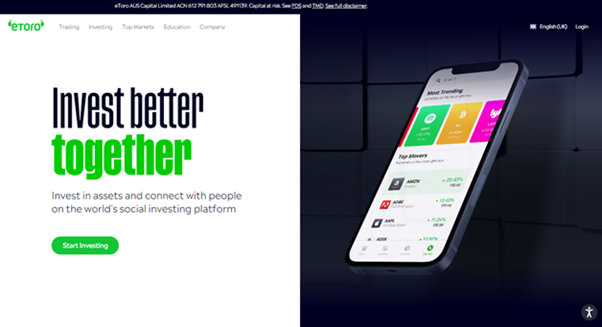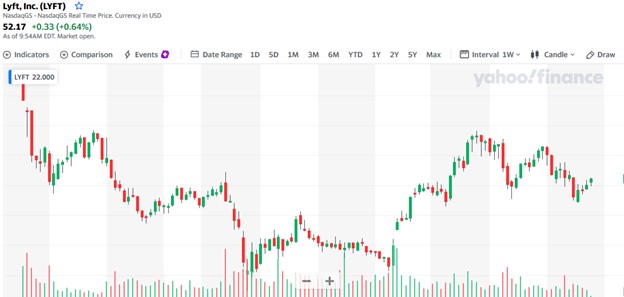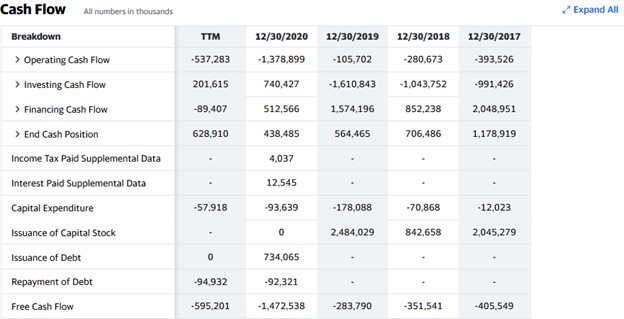How to buy Lyft stocks in 2026

Lyft is a transportation-as-a-service company that operates a peer-to-peer community for on-demand ridesharing in the United States and Canada. The company provides a variety of transportation solutions, including an online ridesharing marketplace where drivers can meet riders, and car rental services to drivers for short and long-distance trips, and a network of shared bikes and scooters in various cities for short trips.
Additionally, Lyft integrates third-party public transit data into the Lyft app to provide its customers with information about nearby public transit routes, as well as supplement public transit by providing rides for the first and last leg of commute trips. The company is also developing autonomous self-driving vehicles.
This guide shows you how to buy Lyft stock and why it’s a good idea, as well as the various fundamental analysis factors to consider before investing.
How to Buy LYFT Stocks in 5 Easy Steps
-
1Visit eToro through the link below and sign up by entering your details in the required fields.
-
2Provide all your personal data and fill out a basic questionnaire for informational purposes.
-
3Click 'Deposit', choose your favourite payment method and follow the instructions to fund your account.
-
4Search for your favourite stock and see the main stats. Once you're ready to invest, click on 'Trade'.
-
5Enter the amount you want to invest and configure your trade to buy the stock.
The Best 3 Brokers for Investing in Lyft
1. eToro
eToro is a social trading and investment platform that allows users to trade a variety of assets, including cryptocurrencies. The platform is designed to be user-friendly and intuitive, making it a good choice for those new to investing. eToro also offers some features that can be useful for more experienced investors, such as the ability to copy other traders' portfolios. You can read our full eToro review here.

Security and Privacy
eToro takes security and privacy seriously, offering features such as 2-factor verification and encrypted passwords to keep user accounts safe. The platform also offers a strict anti-money laundering policy to protect users from fraud. To prevent abuse of the platform, they have put several security features in place, such as data loss prevention and restriction of access based on IP address. When a user invests, an additional security feature blocks the transaction from being executed if the account is linked to a potentially fraudulent user. In addition, they employ top vendors, web solutions, and firewalls, constantly on the alert to block a possible cyber-attack.
They take users’ privacy of utmost importance and never share their personal information without their consent.
Fees and Features
One of the most attractive features of eToro is that it is a multi-asset platform which gives access to over 2,000 financial assets like stocks, ETFs, indices, Cryptocurrencies and many more. eToro offers users Free Insurance that would cover claims in case of insolvency or an event of misconduct. Another feature that makes this platform one of the best around is the social trading feature. You can join a community of 20 million traders all around the world and connect with like-minds to shape your trading decisions. Lastly, the CopyTrader feature allows you to use the performance of some seasoned investors to know the one to replicate.
eToro offers 0% commission when you open a long, non-leveraged position on a stock or ETF with no management fees or deposit fees. However, the platform charges an inactivity fee of $10 per month if you don’t trade for 12 months. There is also a low fixed $5 fee for withdrawals.
| Fee Type | Fee Amount |
| Commission Fee | 0% |
| Deposit Fee | None |
| Withdrawal Fee | $5 |
| Inactivity Fee | $10 (monthly) |
Pros
- Security and Privacy
- Low fees and commission
- Copytrading
- Social trading
Cons
- High inactivity fee
- Limited customer service
2. Capital.com
Capital.com offers a variety of investment products and services to its clients. These include stocks, indices, commodities, shares, crypto, and forex. Capital.com has a wide range of clients, including retail investors, institutional investors, and high-net-worth individuals. You can read our full Capital.com review here.

Security and Privacy
Capital.com is licensed by several top regulatory bodies, including the FCA, CySEC, ASIC, and the FSA. This indicates that Capital.com customers are well safeguarded and that the platform adheres to strict guidelines to guarantee that consumer information is secure and hidden. In addition, Capital.com’s compliance with PCI Data Security Standards is another way it safeguards its customers’ information.
Every deposit made by retail customers is protected by the Investment Compensation fund according to regulatory guidelines.
Fees and Features
With CFD trading, customers have access to over 6,000 markets with tight spreads. Capital.com offers educational materials that can help customers to make more informed decisions. Another feature Capital.com offers is Spread betting. This gives customers access to speculate on upward and downward moves on over 3000 markets. The broker provides a tool powered by AI in its mobile trading app that offers individualized trading insights by utilizing a detection algorithm to uncover different cognitive biases.
Capital.com charges no fees on deposit, withdrawal, commission or inactivity.
| Fee Type | Fee Amount |
| Commission Fee | 0% |
| Deposit Fee | None |
| Withdrawal Fee | None |
| Inactivity Fee | None |
Pros
- Tight spreads
- 0% commission with no hidden charges
- Artificial Intelligence
- Risk management tools
- Educational materials
Cons
- Overnight fees
- Mostly restricted to CFDs
3. Skilling
Skilling is an online trading platform that offers users the ability to trade a variety of financial assets, including forex, CFDs, and cryptocurrencies. The platform is designed to be user-friendly and provides traders with all the tools and resources they need to start trading. Skilling also offers a demo account so that users can practice trading before they start trading with real money. You can read our full Skilling review here.
Security and Privacy
The security and privacy of the Skilling online trading platform are taken very seriously. All information entered into the platform is encrypted and stored securely. Only authorized personnel have access to this information. In addition, the platform uses two-factor authentication to ensure that only authorized users can access account information. Skilling is regulated by the Cyprus Securities and Exchange Commission (CySEC), which means customers can rest assured about the security of their assets.
Fees and Features
Skilling has four different platforms; Skilling Trader, Skilling cTrader, Skilling MetaTrader 4 and Skilling Copy. Skilling Trader is designed for traders on all levels with access to all the tools needed for trading analysis. Skilling cTrader on the other hand is designed for advanced traders with a focus on order execution and charting capabilities. MetaTrader 4 is a forex and CFDs trading platform with a very versatile and easy-to-customise interface. Skilling Copy is a copy trading platform which allows members to have access to follow or copy trading strategies of seasoned traders at a fee.
Skilling does not charge any fee for inactivity, deposit or withdrawal. However, there are commission charges on FX pairs and Spot Metals on the Premium account type. These charges start from $30 per million USD traded.
| Fee Type | Fee Amount |
| Commission Fee | Varies |
| Deposit Fee | None |
| Withdrawal Fee | None |
| Inactivity Fee | None |
Pros
- Reliable 24/5 customer support
- Over 1000 trading instruments
- Superb licensing and regulation
- Demo account
Cons
- Not enough educational materials
- High Spreads
- Service is unavailable in many countries including the US and Canada.
Everything You Need To Know About Lyft
Now, let’s take a more detailed look at Lyft as a company, exploring its history, business strategy, how it generates revenue, and its financial performance in the last few years.
Lyft History
Lyft started as a service of Zimride, a company founded in 2007 that offers long-distance intercity carpooling service that matches inter-city drivers and passengers through social networking platforms. Lyft was launched in May 2012 to offer intra-city rides. While Zimride focused on university campuses, Lyft was launched as a ridesharing service for shorter trips within cities.
The Lyft app grew rapidly and became the focus of the company. In May 2013, it officially changed its name from Zimride to Lyft. In July 2013, Lyft sold the Zimride service to Enterprise Holdings so as to focus exclusively on the growth of its intra-city short trips.
In August 2014, Lyft introduced the shared-ride concept to make fares cheaper. Lyft expanded into Canada in December 2017, offering its services in Toronto, Hamilton, and Ottawa. In March 2019, Lyft held its IPO, becoming the first ride-sharing company to do so. The IPO raised $2.34 billion, and the company was valued at $24.3 billion.
What Is Lyft’s Strategy?
Lyft’s business strategy has expanded from providing an online platform that connects intra-city drivers to riders to offering a multimodal platform that gives a wide array of transportation solutions, as well as experimenting with autonomous driving and robotaxis.
Some of its solutions include Express Drive, which offers a car rentals program for drivers; Lyft Rentals, which offers vehicle rental service for long-distance trips; Lyft Pass, which enables organisations to create custom transportation programs; enterprise programs, such as monthly ride credits for daily commutes and providing rides for the first and last leg of commute trips to supplement public transportation; and a network of shared bikes and scooters for short intra-city trips.
How Does Lyft Make Money?
Lyft generates revenues primarily from the money collected by the drivers for completing rides on the platform. Every time a user gets a ride via the Lyft app, the company gets 20% of the fare for the ride, while the rest go to the driver. Another key source of revenue for Lyft is subscription fees and single-use ride fees riders pay to gain access to the company’s network of shared bikes and scooters.
With more than 10 million weekly active riders, Lyft has been the main competitor to Uber in the North American ride-sharing market, taking over 39% of the market as of September 2021. Since the company only operates in the U.S. and Canada, it still has substantial growth potential if it chooses to expand to other countries.
How Has Lyft Performed in Recent Years?
Lyft went public in March 2019. Since then, the stock has had a mixed performance at best. The stock was offered at $72 per share but steadily fell below $21 in March 2020, following the coronavirus pandemic. Since then, the stock has recovered to a great extent, getting up to $68 per share in March 2021 before making a two-legged pullback to the $45 level. As of September 2021, the stock is emerging from the second leg of the pullback.

Source: Yahoo! Finance
While Lyft’s stock performance has not been impressive since its IPO, the stock, just like the rest of the market, is recovering from the pandemic that disrupted the economy and was particularly devastating to the transportation industry.
Where Can You Buy Lyft Stock?
Lyft stock is listed on the Nasdaq Exchange and can be bought through a stockbroker that is registered with the exchange. US-based stockbrokers or major international stockbrokers have access to most big stock exchanges around the world, including Nasdaq, so you need to open an account with an online broker.
Many stockbrokers offer just the standard trading accounts, but UK-based brokers and American brokers with UK offices also offer ISA and SIPP accounts, which are tax-friendly. While buying shares gives you part ownership of the company, spread betting and CFD trading do not offer you ownership rights to the company; instead, these come with other benefits, such as ease of trading, cost-friendly operations, and faster execution speeds. Some stockbrokers offer both derivatives and real assets for trading.
Another way to buy Lyft stock is through the share dealing arm of any of the major banks in your country of residence.
Lyft Fundamental Analysis
Fundamental analysis is a way to evaluate a stock by studying the company’s business to know its real value and project how it might perform in the future. This method of analysis is used by long-term investors, unlike traders who mostly use technical analysis.
Investors consider certain financial factors, including corporate management and goodwill which are not measurable, when conducting fundamental analysis of a stock. However, in this guide, we will focus on measurable financial metrics, such as the company’s revenue, earnings-per-share, P/E ratio, dividend yield, and cash flow.
Lyft’s Revenue
The revenue of a company is the amount of money it makes from the sales of its products or services before subtracting the costs of sales and other expenses. Revenues are typically reported at the top of the income statement, so it’s often referred to as the top line.
Year-on-year revenue growth is good for any company. Expectedly (due to the pandemic that disrupted movement), Lyft’s revenue for the 2020 fiscal year declined by 34.6% (from $3.62 billion in 2019 to $2.36 billion in 2020) compared to the 2019 fiscal year.

Source: Yahoo! Finance
Lyft’s Earnings-per-Share
Earnings are the remaining profits after all costs of doing business have been deducted from the revenue for the accounting period. But, you should be more interested in earnings per share (EPS) because you can find out how much earnings you get depending on how many shares you own.
EPS is calculated by dividing the company’s total earnings by the total number of outstanding shares of its common stock, but you don’t need to calculate it yourself. You can get it from your stockbrokers’ websites or any of the major financial websites. Lyft’s EPS for the 2020 fiscal year was -$0.58; that is, the company made a loss.

Source: Yahoo! Finance
Lyft’s P/E Ratio
A company’s price-earnings (P/E) ratio compares its share price to the earnings-per-share. It is calculated by dividing the current share price by the EPS.
Lyft made a loss in the 2020 fiscal year and has not made any profit in 2021. Thus, while we know the share price, we cannot calculate the P/E ratio because it would give a negative value that is not useful in analysis.
But on a general note, a very high P/E ratio may mean that the stock is overvalued, while a low ratio may indicate that the stock is undervalued.
Lyft’s Dividend Yield
Dividends are a portion of a company’s earnings distributed to its shareholders. Some companies that pay dividends may do so quarterly, semi-annually, or annually. Generally, a company’s share price rises when it declares dividends, but after the ex-dividend date, the stock declines.
A company’s dividend yield is its total annual dividends expressed as a percentage of its share price. For example, if a company pays out a total of $5 in dividends for the year and its share price is $100, its dividend yield would be 5%. When you compare the yield with the interest rate, it tells you whether it makes more sense to keep your money in the bank than invest it in that stock.
You can see the dividend yield on your stockbroker’s website or any of the major financial websites. As of September 2021, Lyft has not declared or paid a cash dividend, and it may not be doing so in the foreseeable future as it intends to retain any future earnings.
Lyft’s Cash Flow
A company’s cash flow statement records how cash and cash equivalents flow in and out of the business. You will see the cash flow statement beside the other financial statements in the financials section of the company’s information on a website like Yahoo Finance or even on your broker’s website.
When analysing the cash flow statement, your interest should be on the free cash flow figure, which is the amount of cash or its equivalents left for the company after taking care of major expenses necessary for running its business, such as the mortgage, equipment, and other bills. The company can use its free cash to fund expansion, pay dividends, or pay down debts.
Lyft’s cash flow statement for the 2020 fiscal year can be seen below:

Source: Yahoo! Finance
Why Buy Lyft Stocks?
Although Lyft has not made any profits in more than two years since its IPO, the stock still has long-term growth potential. The poor performance can be attributed to the coronavirus pandemic, which wreaked havoc on the ride-hailing industry. Demand was too low because restaurants, bars, and entertainment venues were closed.
Lyft has made some improvements in its cost structure and launched complimentary services to nurture growth. As economic activity picks up, the company’s business is likely to soar, and here’s why:
- With the availability of the vaccines, restrictions on dining and leisure activities are already being lifted, providing a conducive environment for the company’s business.
- Lyft’s cash-free ride-hailing service is now available in more than 600 U.S. cities and Canada, and the Lyft app is resonating with millennials.
- Lyft now offers a fleet of bikes and scooters for short-distance travel in various cities, and this can be a game-changer for the company’s growth.
Expert Tip on Buying Lyft Stock
“ Things may not be looking great for Lyft stock at the moment (September 2021), both on the stock market and the financial statements. However, Lyft can be considered a growth stock with enormous long-term prospects. Interestingly, the company’s management is shrewdly restructuring costs and expanding into key services that can drive growth. It is a good time for smart growth investors with a long-term outlook to gradually accumulate positions in the stock, especially now that the stock is still in a dip. ”- willfenton
5 Things to Consider Before You Buy Lyft Stock
You must consider these five things before buying Lyft stock:
1. Understand the Company
As suggested by great investors, like Peter Lynch and Warren Buffett, it is okay to invest in a company you are familiar with (for example, one whose products you regularly use). It could be that you frequently take Lyft rides or even use it to go to work every day. However, you should look beyond that, as it is not enough reason to invest in the stock. Make sure you study the company’s fundamentals to know how the company stands to make money in the future before you invest.
2. Understand the Basics of Investing
It is important to understand the basics of investing before approaching the market. Look for some books about investing or read some financial blogs to understand certain terms and processes so you can make sense out of financial statements or experts’ analyses. More importantly, learn about risk management, money management, and diversification so you know how to protect your capital when investing. Better still, “paper trade” with a demo account for some time before trading with real money, and when you eventually start trading real money, start with a small amount first.
3. Carefully Choose Your Broker
Be sure that the stockbroker you choose is regulated in your country of residence. Using a regulated broker can offer some form of protection: your fund will be insured against brokerage bankruptcy and you may benefit from negative balance protection. You should also consider the broker’s asset offerings, trading commissions, trading platforms (desktop, web, or mobile), payment methods, and customer support service.
4. Decide How Much You Want to Invest
You should know how much to budget for investment and the percentage you want to commit to one stock. For example, determine how much you want to invest in Lyft and how to do it: do you invest all at once or practice dollar-cost averaging? Whichever way you want to invest, do not invest more than you can afford to lose and avoid using borrowed funds, including the leverage offered by your broker, unless you know how to safely use it. While leverage can increase potential profits, it can also amplify losses.
5. Decide on a Goal for Your Investment
You must have an investment goal. Why are you investing, and what do you hope to achieve with the investment? It may be to build your pension fund for retirement or raise money for your kid’s college. Whatever the reason, you should know how long to hold the investment and when to cash out. This could be when the price gets to a particular level, when the fundamentals are weak, or when you need the money. You may also choose to buy and hold indefinitely.
The Bottom Line on Buying Lyft Stocks
Now, let’s take a look at the key points of this guide.
Lyft is a transportation-as-a-service company that provides a variety of transportation solutions, including an online ridesharing marketplace, car rental services for short and long-distance trips, and a network of shared bikes and scooters for short trips within the city. The stock has long-term growth prospects, and you can buy it via a stockbroker with access to the Nasdaq exchange.
Ready to invest right now? Sign up for a stockbroker’s share dealing account, look for Lyft in its list of stocks, and then hit the “buy” button to buy at a quoted price or place a limit order to buy at the maximum price you’re willing to pay.
If you’re not ready to invest right now, read our other guides to learn more about investing. You may “paper trade” using a stockbroker’s demo account to learn more about the market.
Frequently Asked Questions
-
This is an investing technique according to which the investor splits their capital into many portions and buys the stocks gradually over regular intervals, irrespective of the price. The idea is to reduce the impact of volatility and avoid making a poorly timed purchase.
-
Risk management refers to the procedures traders use to keep losses under control and maintain a good risk/reward ratio. For instance, it may be about setting a stop-loss order which gets them out of a trade if the market is going against their position beyond a specified level. Risk management helps traders to avoid losing all their money in one trade.
-
This is a technique used by traders and investors to protect their trading capital. The idea is to commit a small fraction (often 1-3%) of the capital in one trade so as to limit your losses if one asset goes down.
-
Diversification is an investing technique in which the investor allocates their capital across different assets and different industries. The aim is to reduce market risk while maximising returns. So, it is one of the methods you can use to manage risks when investing.
-
Yes, you can trade Lyft stock over the short-term because the stock moves in sizable swings that can be traded and the liquidity is fair. However, the stock has long-term prospects and presents a great opportunity for growth investors who can wait for it.
-
Technical analysis is a way of evaluating a stock for trading opportunities by using the historical price movement to forecast how the price might move in the future. A technical trader looks for specific price patterns or uses some technical indicators to know when to make a trade. You can use this method if you want to swing trade Lyft stock.






